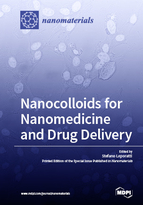Nanocolloids for Nanomedicine and Drug Delivery
A special issue of Nanomaterials (ISSN 2079-4991).
Deadline for manuscript submissions: closed (30 April 2018) | Viewed by 97250
Special Issue Editor
Interests: nanomedicine; drug delivery; scanning force microscopy; cytomechanics; nanocarriers
Special Issues, Collections and Topics in MDPI journals
Special Issue Information
Dear Colleagues,
This Special Issue of Nanomaterials, “Nanocolloids for Nanomedicine and Drug Delivery”, focuses on new development of tailored nano-systems for targeted drug delivery.
Nanomedicine is an interdisciplinary field where nanotechnology, nanoscience and nanoengineering interact with life sciences. It is expected to lead to the development of novel nanosystems, drugs and other applications for diagnosis and therapy. Furthermore nanoparticulates drug delivery are new attractive vehicles for transport and release drug on a targeted site.
This Special Issue will highlight on novel nanocolloids like magnetic nanoparticles, nanomicelles, nanoliposomes, nanocapsules and nanoclays, stimulating novel interests and ideas in research groups involved in the development of novel nanotools within the different areas of nanomaterials. The publication of original articles will contribute to the scientific progress in the area of personalized medicine and further stimulate the entering into clinical praxis of such new nanosystems.
- Nanocolloids
- Nanomedicine
- Nanoclays
- Nanoliposomes
- Nanomicelles
- Nanocapsules
- Drug Delivery
Prof. Stefano Leporatti
Guest Editor
Manuscript Submission Information
Manuscripts should be submitted online at www.mdpi.com by registering and logging in to this website. Once you are registered, click here to go to the submission form. Manuscripts can be submitted until the deadline. All submissions that pass pre-check are peer-reviewed. Accepted papers will be published continuously in the journal (as soon as accepted) and will be listed together on the special issue website. Research articles, review articles as well as short communications are invited. For planned papers, a title and short abstract (about 100 words) can be sent to the Editorial Office for announcement on this website.
Submitted manuscripts should not have been published previously, nor be under consideration for publication elsewhere (except conference proceedings papers). All manuscripts are thoroughly refereed through a single-blind peer-review process. A guide for authors and other relevant information for submission of manuscripts is available on the Instructions for Authors page. Nanomaterials is an international peer-reviewed open access semimonthly journal published by MDPI.
Please visit the Instructions for Authors page before submitting a manuscript. The Article Processing Charge (APC) for publication in this open access journal is 2900 CHF (Swiss Francs). Submitted papers should be well formatted and use good English. Authors may use MDPI's English editing service prior to publication or during author revisions.







